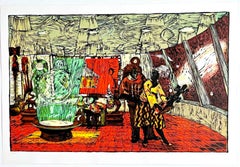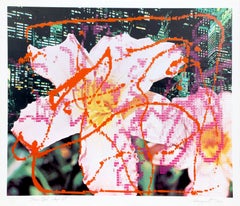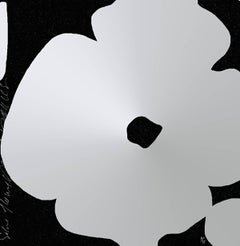Kerry James Marshall Abstract Prints
In his multifaceted work, Kerry James Marshall strives to address “the lack in the image bank” by elevating Black figures who have been excluded from Western art. Using a variety of black pigments, the artist heightens the skin tones of his subjects to honor their identities rather than ignore them. Best known for his large-scale paintings, Marshall also works in collage, photography, video and other media.
Born in Birmingham, Alabama, Marshall later grew up in the Watts neighborhood of Los Angeles, where his family relocated in 1963. As he studied art, including at the Otis Art Institute (now Otis College of Art and Design) in Los Angeles, he was struck by the absence of Black bodies in art history and museums. At the age of 25, he painted A Portrait of the Artist as a Shadow of His Former Self (1980). Its central figure, whose features almost merge with the background in their varying shades of black, references Ralph Ellison’s Invisible Man, the protagonist of which cannot be seen as a human being by other members of society because he is Black. For Marshall, A Portrait marked the start of an ongoing examination of the simultaneous visibility and invisibility of Black Americans.
Marshall’s practice has continued to concentrate on confronting stereotypes in the Black experience by celebrating joy and commemorating moments of Black history. His paintings frequently engage with the white-dominated traditions of the art historical canon by borrowing elements of style ranging from the Renaissance to the abstract movements of the 20th century. While he has said that he is driven by a sense of social responsibility for what he witnessed growing up in the South before the Civil Rights Act and in Los Angeles during the Watts riots of 1965, Marshall doesn’t focus on trauma in his works’ narrative scenes. Instead, they regularly depict people involved in everyday activities yet portrayed with the monumentality of a tableau painting.
Now based in Chicago, Marshall is recognized as one of the country’s leading contemporary painters, with a 2016 retrospective, "Mastry," touring the MCA Chicago, MOCA and the Metropolitan Museum of Art. In 2018, his painting Marshall’s Past Times (1997) sold for $21.1 million, the highest ever auction price for a work by a living Black artist.
Browse a collection of Kerry James Marshall’s art on 1stDibs.
2010s Contemporary Kerry James Marshall Abstract Prints
Mixed Media, Pencil, Linocut, Screen
Early 2000s Pop Art Kerry James Marshall Abstract Prints
Screen
1980s Pop Art Kerry James Marshall Abstract Prints
Screen
21st Century and Contemporary Contemporary Kerry James Marshall Abstract Prints
Screen
1970s Pop Art Kerry James Marshall Abstract Prints
Screen
2010s Contemporary Kerry James Marshall Abstract Prints
Screen
20th Century Pop Art Kerry James Marshall Abstract Prints
Screen
1970s Pop Art Kerry James Marshall Abstract Prints
Screen, Lithograph
1970s Pop Art Kerry James Marshall Abstract Prints
Screen
2010s Contemporary Kerry James Marshall Abstract Prints
Screen
1970s Pop Art Kerry James Marshall Abstract Prints
Screen
Early 2000s Contemporary Kerry James Marshall Abstract Prints
Ink, Screen
1970s Pop Art Kerry James Marshall Abstract Prints
Screen
2010s Contemporary Kerry James Marshall Abstract Prints
Paper, Linocut
Kerry James Marshall abstract prints for sale on 1stDibs.
Artists Similar to Kerry James Marshall
- 1stDibs ExpertApril 5, 2022Kerry James Marshall is famous for using a variety of black pigments to depict themes of the black experience and history. His works confront stereotypes of African-Americans by celebrating and commemorating moments in their history. Browse a selection of Kerry James Marshall art on 1stDibs.
- Where is Kerry Marshall's art?1 Answer1stDibs ExpertMarch 22, 2022Kerry Marshall's art is in galleries and museums located around the world. Some of these institutions include Modern Art Oxford in Oxford, UK; the San Francisco Museum of Modern Art in San Francisco, California; the Baltimore Museum of Art in Baltimore, Maryland; and the Museum of Fine Arts in Boston, Massachusetts. You'll find a selection of Kerry Marshall art on 1stDibs.
- 1stDibs ExpertApril 5, 2022Kerry James Marshall is known for his acrylic paintings that pair realism with elements of collage and signage. Strongly influenced by childhood experiences in the Watts neighborhood of Los Angeles, his art reflects this by confronting racial stereotypes in contemporary society. On 1stDibs, find a variety of original artwork from top artists.


